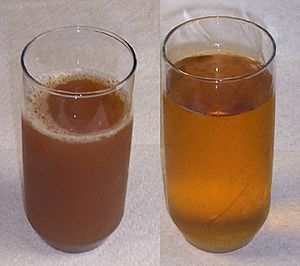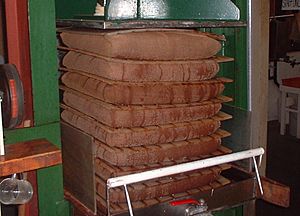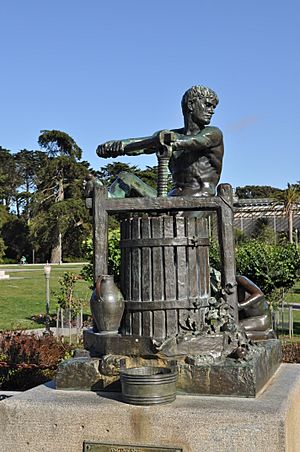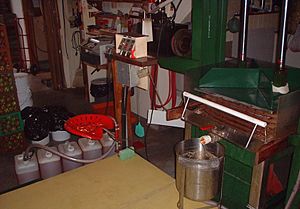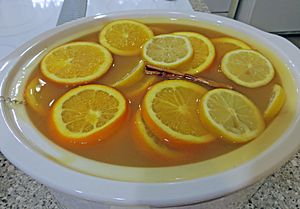Apple cider facts for kids
Apple cider is a tasty, non-alcoholic drink made from apples. It's also called sweet cider or soft cider. In the United States and Canada, when people say "cider," they usually mean this fresh, non-alcoholic version.
It's different from the alcoholic drink called "cider" in many other parts of the world. In the US, that alcoholic drink is called "hard cider." Apple cider is made by pressing apples to get their juice. This juice is usually cloudy because it still has tiny bits of apple in it. It often tastes a bit sharper than regular clear apple juice.
Cider is usually treated with heat (called pasteurized) to kill germs and help it stay fresh longer. But you can also find untreated cider. Apple cider is a special autumn drink, often enjoyed around Halloween, Thanksgiving, Christmas, and New Year's Eve. Sometimes, people warm it up and add spices, which is called "mulled" cider.
Contents
What's in a Name?
The word "cider" can be a bit confusing! In most countries, "cider" means an alcoholic drink made from fermented apples. But in the United States, "cider" usually means the fresh, non-alcoholic apple drink. If Americans want the alcoholic version, they say "hard cider." In Canada, they often say "apple cider" for the fresh drink and "cider" for the alcoholic one.
Some places try to explain the difference between apple juice and apple cider. For example, in Massachusetts, fresh cider is described as raw apple juice that hasn't been filtered. This means it still has small pieces of apple pulp in it. Apple juice, on the other hand, is filtered to remove these bits and is usually pasteurized to make it last longer.
Natural Cider
A long time ago, all cider was made naturally without any special treatment. Over time, tiny yeasts from the air or on apple skins would start to ferment the cider. This process would create alcohol, which helped keep bad germs from growing.
When modern refrigerators were invented, cider could be kept cold for a long time. This stopped it from fermenting. However, if the cider got warm, germs could grow. Because of this, governments now require most cider sold in stores to be treated with heat or other methods to keep it safe to drink.
Today, natural, untreated cider is a special treat you can often find at apple orchards or small farms during the autumn. It's usually made from a mix of different apple types to give it a balanced flavor. The US government requires a warning label on bottles of untreated cider to let people know it hasn't been pasteurized.
Even when kept cold, raw cider will slowly start to bubble and eventually turn into hard cider as it ferments. Some people let this happen on purpose to make hard cider. Others let it go even further to make apple cider vinegar.
How Cider Is Made Today
Making cider has changed a lot from olden times. Back then, people used big stone wheels or hand presses to crush apples. Today, most small cider makers use electric machines. These machines have a "rack and cloth press" system.
To make cider, apples are first washed and then ground into a mush, like thick applesauce. This mush is then put into layers, often wrapped in special cloths, and stacked on racks. A powerful machine then presses these layers together, squeezing out the juice.
Some larger places use a "belt filter press." This machine squeezes the apple mush between two moving belts, which pushes the juice out very efficiently. The fresh juice is then stored in cold tanks. It's usually pasteurized (heated) to kill any germs and make it last longer before being bottled and sold.
The leftover apple pulp after pressing is called pomace. This pomace is often sold to farmers to feed their cattle.
Fun Cider Variations
- Hot Mulled Cider: This is a very popular drink in the fall and winter. Cider is heated up, but not boiled, and spices like cinnamon, nutmeg, and cloves are added. It smells and tastes wonderful!
- Sparkling Cider: Real sparkling cider gets its bubbles naturally from a little bit of fermentation. But sometimes, you'll see "sparkling apple juice" sold as "sparkling cider." This kind is usually filtered, pasteurized, and has bubbles added artificially.
- Rosé Cider: You can make a beautiful pink (rosé) apple cider by using apples that have red flesh inside.
- Cider Doughnuts: These delicious doughnuts traditionally used the natural yeast in raw cider to help them rise. Today, you can often find them at cider mills and roadside stands, especially in the fall. Visiting apple orchards to pick apples and enjoy cider and doughnuts is a fun autumn activity for many families.
Cider's Special Place
Apple cider is so loved in New Hampshire that it's the official state beverage there!
|


